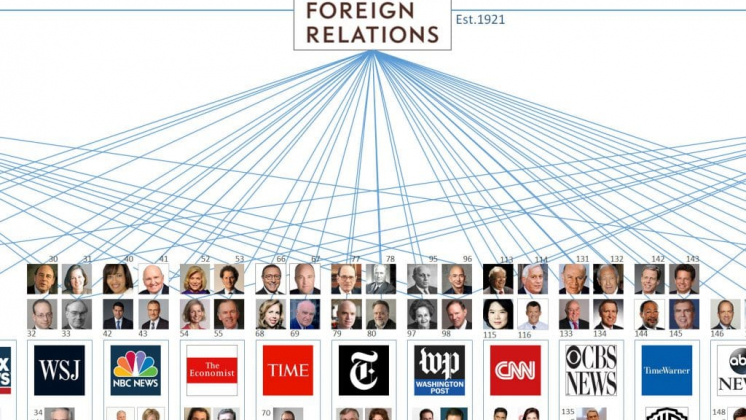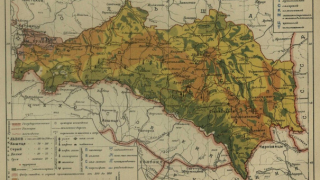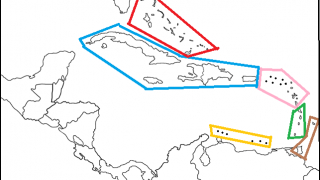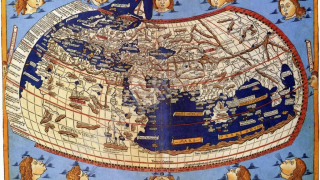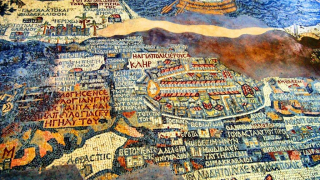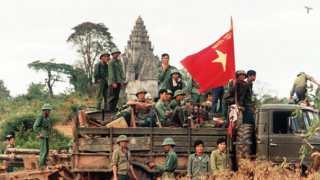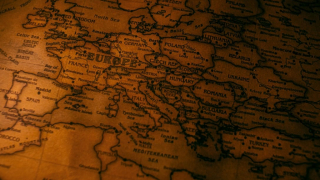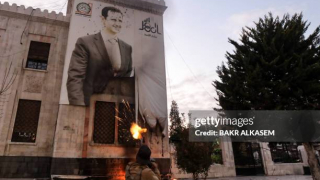The Council of Foreign Relations, the “miracle weapon” of Atlantic geopolitics
Two extreme views on the driving forces of history have long existed. The first is that history is subject to strict objective laws, which depend little on the will of kings, presidents and, a fortiori, mere mortals. The only thing that can be done is to learn the laws so that, by grasping the meanings and trends, one can help history do its work as efficiently and painlessly as possible. This view has been most consistently embodied by historical materialism.
The other extreme sees history as a conspiracy. In this conspiratorial approach, history appears as a continuous stream of intrigue, separate negotiations, under-the-table deals, assassination attempts and coups. For the conspiracy theorist, “riding the tiger” of history means creating one's own secret societies and exposing those of the enemy, weaving one's own intrigues and foiling those of others.
Both points of view are relevant in their own ways. History undoubtedly has laws and meanings, which it is necessary to know in order to act with it, not in spite of it. One of the main characters in our narrative, Allen Dulles, stated that “it is easy to confuse a man with facts, but once he understands the tendencies he cannot be fooled” [1].
But there is equally no doubt that conspiracies and secret societies play an important role in historical disruptions. Secret lodges and conspiracies have overthrown powerful dynasties and made revolutions in seemingly more prosperous societies, reversing the course of history by 180 degrees and casting leaders as hopeless outsiders. History is not so much chess as it is bridge, not only a science but also the art of outsmarting the opponent, hiding the main winning cards until the last moment. However, when it comes to tactical victory, or when history is at a bifurcation point (i.e., when a small impact on the system can lead to unpredictable consequences) then the game turns into a game of poker, where the main task is to deceive the opponent. It is in these moments that the treacherous tools of conspiracy emerge.
The West has managed to combine both extremes, creating a truly miraculous weapon: think tanks. On the one hand, they are powerful centres of research and analysis (“universities without students”, as they were called before World War II). On the other hand, the more closed and secretive these “factories” were, the more effective they were. The incredible effectiveness of the Thought Factories was due to a clever combination of research, intelligence and subversive activities, and a cunning network organization that concealed the real targets and beneficiaries. “Thought factories are intertwined with the political class (establishment), intelligence services, and financial and industrial elites in the most intimate way, orchestrating complex interactions between different groups, sometimes competing fiercely with each other. Thought factories are the brains and hands of what is now commonly referred to as the 'deep state'” [2].
They are a powerful ideological and political backbone of the Western (primarily American) establishment, its intellectual backbone and potential. According to N.A. Narochnitskaya, “these powerful generators of ideology create subtle and indirect axioms of worldview for the initiated and stereotypes for the layman; their extensive international activity supersedes and complements the work of U.S. diplomacy and ideological intelligence. Finally, they are the blood-brain of the elites through which ‘true knowledge’ circulates as the media masterfully identifies U.S. interests with the ethical-moral canons of the universe and processes the demos of millions, naively convinced of their supposed ‘kratia’” [3].
The raison d'être of think tanks: propaganda, ideology creation and implementation, development and control of public and political discourse, indoctrination, public opinion training and research, public policy development on a wide range of issues (outsourcing and lobbying), data collection and analysis, analysis and journalism, book and media publication, customer service, staff training, a well-paid haven for retired politicians, military and government officials. The “thought factories” are at the top of the information pyramid, through which real governance takes place.
The work “Thought Factories as an Integral Part of the Western Supersociety” by Vladimir Maslov [4] provides unique data on “thought factories” that have been declassified from a set of circumstantial data. The list contains 155 organizations, revealing their personnel and budgets. These include such well-known and influential organizations as the Carnegie Foundation, the Hoover Institution, the World Resources Institute, the Heritage Foundation, the RAND Corporation, Human Rights Watch, Freedom House, and others.
Among them, at a modest 12th place, is the Council on Foreign Relations (CFR), one of the most powerful instruments of U.S. geopolitics, the subject of our analysis.
When Karl Polanyi coined the notion of “pernicious intellectual superiority” [5] of Third Reich leaders over their opponents as one of the main reasons for Hitler's early success, he had in mind not so much knowledge as treachery aimed at the destruction of the existing world order. Exactly the same circumstance, the sinister intellectual superiority of Western elites, played an important role in liberalism's victory in the struggle for world hegemony. And the most effective tools for achieving this “sinister intellectual superiority” were and still are the “think tanks”, not least the Council on Foreign Relations.
The birth of the WRC
In the first quarter of the 20th century, the American Idea, which had circulated in the public mind as a syncretic fusion of John O'Sullivan's Manifest Destiny and Monroe's isolationist doctrine, underwent a significant change. The United States found itself embroiled in World War I. After the Peace of Versailles, the United States begins to rethink its place in the world system. Whereas Manifest Destiny had previously manifested itself in a strategic project to gain American independence from the European powers and establish control over Central and Latin America (the Monroe Doctrine proper), the United States now felt ready to extend its interests and values beyond the American continent - complicity in the victory over Germany provided a historical perspective. Moreover, England, a former maritime empire, was losing control of its colonies on its watch, leaving a significant power and influence vacuum. In contrast, the American economy was booming, and the United States gradually began to purchase British colonies and impose its economic and political control there under the guise of independence and democracy. Thus, was born the Wilson Doctrine, which replaced the Monroe Doctrine. Henceforth, the whole world became the territory designated for American strategic control and the spread of American values (democracy, human rights, free enterprise) [6].
From its founding in 1921, the Council on Foreign Relations was conceived as the most influential think tank for strategic decisions in the field of international relations. A precursor to the creation of the Council could be considered the establishment in 1917 by U.S. President Woodrow Wilson of the Inquiry, a research group of 150 scientists that had been mobilized in 1917 by Woodrow Wilson's close advisor, “Colonel” Mandel House, and journalist Walter Lippmann, who was the U.S. Undersecretary of Defense, to develop a new vision of the U.S. global role in the postwar world. The enterprise was financed by leading U.S. bankers (notably Rockefeller, Warburg and Morgan). The immediate fruit of this work was Wilson's Fourteen Points, which outlined a new American strategy for peace after World War I and was in many ways a reaction to Lenin's Peace Decree.
The Inquiry has since become the centre of institutionalization of the entire Anglo-Saxon and, more generally, Western geopolitical tradition that privileges the “civilization of the sea” and the prospect of its planetary domination. Since its inception, the WSC has sought to be the intellectual centre of global politics, a kind of codifier of “world government”, understood as an instance of global control on behalf of the geopolitical subject of the “civilization of the sea”. Geopolitics would henceforth develop predominantly within the framework of this organization and its associated scientific, political and intelligence structures [7].
At the end of World War I, Wilson travels to Europe to attend the Versailles peace conference in person. He is accompanied by five personal assistants, including Colonel House, and 23 members of the Inquiry. The American delegation imposes its modus operandi on its partners: it forbids discussion of peace agreements until the countries have determined what that peace will be. It also shares its plans for a world open to trade without customs restrictions and regulations. In fact, these plans reflect what would later be called globalization. He also supports the creation of a League of Nations, the purpose of which would be to prevent wars. This plan was largely corrected by the Europeans and finally rejected by the U.S. Congress, which thus expressed its disapproval of Wilson [8].
At the same time, the British and American delegations decided to establish an Academy outside the Peace Conference, which would bring the two states together. Its purpose would be to institutionalize the activities of the Inquiry, which would help develop and promote a common Atlantic foreign policy strategy. Eventually, the Anglo-American Institute of International Relations split into two independent divisions, one based in New York and the other in London. The U.S. division, the Council on Foreign Relations, is organized by Eliu Root, Secretary of State under Theodore Roosevelt (who sanctioned the U.S. invasions of Cuba, Honduras and the Dominican Republic and nevertheless won the Nobel Peace Prize). At the same time, the British established the Royal Institute for International Affairs (RIIA), better known as Chatham House for its location in an old London palace. It also established a third centre for world governance, the Pacific Studies Unit, based in Europe, but this did not receive much development.
The rules of operation of the WSC and Chatham House are the same as for all research institutes: participants are encouraged to work on set goals outside the organization and under a false name. The core of the new organizations becomes a collection of prominent bankers, industry tycoons, politicians, generals, lawyers, scientists and journalists. Early members include David Rockefeller, John Pierpont Morgan, his attorney, millionaire John William Davis (first chairman of the Council), Herbert Hoover (U.S. president), Averell Harriman (U.S. ambassador to the USSR), John Foster Dulles (secretary of state under President Eisenhower), Allen Dulles (first head of the CIA, chairman of the Council in the years 1946-1950), lawyer Paul Cravat, Paul Warburg (founder of the Fed), bankers Henry P. Davison, Mortimer Schiff, Thomas Lamont, and Russell Lefingwell [9].
The founding members and early officials of Chatham House are no less solid: Lionel Curtis, British statesman Robert Cecil (Nobel Peace Prize winner in 1937), former Foreign Secretary Edward Grey, former Prime Minister Arthur Balfour, Lord Lothian, economist John Maynard Keynes, Oxford professor Alfred Zimmerman, historian Arnold Toynbee [10]. The WSC was sponsored by the Morgan family, John Rockefeller, Bernard Baruch, Jacob Schiff, Otto Kahn, and Paul Warburg.
Interestingly, in the beginning only U.S. and British citizens could work at WSC and Chatham House. The nature of the two organizations developed differently in Britain, turned toward its empire, and in the United States, inclined toward isolationism. These differences are eloquently reflected in the names of the journals they published: Foreign Affairs belonged to LSU and International Affairs to Chatham House.
In 1921, Isaiah Bowman, an American scientist and president of the American Geographical Society, who became one of the main ideologues of Woodrow Wilson's program, assumed the leadership of the WSC. Bowman formulated the concept of a “new world”, in which he described the balance of national interests of various states, preferring that the U.S. gradually achieve world domination. Bowman outlined a geopolitical strategy for the development of the WSC in the following decades: a gradual path toward “world government” in the interests of the Euro-American community through conscious and purposeful U.S. involvement in global processes wherever they occur.
In 1922 Edwin Francis Gay, former dean of Harvard Business School and director of the War Shipping Board, led the Council on Foreign Relations' efforts to publish a journal that would become an “authoritative” source on foreign policy. He raised $125,000 from wealthy Council members and by September 1922 founded the publication of Foreign Affairs, which within a few years earned a reputation as “America's most authoritative journal of international relations” [11].
The prominent British geopolitician Halford Mackinder, who was in the British delegation at the conclusion of the Treaty of Versailles, began working with the Council. Mackinder directly confronted Wilson and his ideological supporters during the preparation of the Versailles Treaty and explicitly interpreted the Wilson Doctrine as a claim by the United States to perform the function of a “world power” on a planetary scale. He readily recognizes the familiar Anglo-Saxon imperialism behind the “idealism” of which he himself was an active supporter. And it is at this point that the two tendencies - British and North American - merge into one common geopolitical tradition, commonly referred to as “Anglo-Saxon” or “Atlanticist”. A. Mahan's views, the developments of American scientists in the field of “political geography”, and the planetary strategy of American domination in the spirit of Woodrow Wilson merge with H. Mackinder's British imperial geopolitics. McKinder's British imperial geopolitics and henceforth a common trend. Mackinder would later publish his political texts in Foreign Affairs, the press organ of CMS. His last article, “The Round Planet and the Victory of the Peace Forces”, in which H. H. Mackinder would publish his views on the political structure of the world after World War II in this very journal [12].
Although there were three formally autonomous centres of government (WSC, Chatham House and Pacific Studies), these centres collaborated closely and, moreover, were deeply integrated into the unique structure of the so-called “Deep State”. The Deep State has its origins in Lord Alfred Milner's Round Table, a British secret society that was concerned with establishing a “world government” under the patronage of the Rothschilds. In fact, Chatham House was an extension of the Round Table. After Lord Milner's death in 1925, references to the Round Table were rare, while references to the Royal Institution were more frequent. Suffice it to say that Milner's secretary was Lionel Curtis, one of the founders of Chatham House. At the same time, in the United States the Round Table was closely associated with the Schiff, Warburg, Guggenheim, Rockefeller and Carnegie families. Some historians explicitly state that WSC was founded in 1921 by the Round Table Society, representing its republication on American soil [13].
A brief success story
Since the late 1930s, the Ford Foundation and the Rockefeller Foundation have contributed substantial sums to the Council on Foreign Relations. In 1938, several international relations committees were created across the country, funded by a Carnegie Foundation grant. These committees influenced local leaders and shaped public opinion to ensure support for Council on Foreign Relations policies and acted as “useful listening points” through which the Council on Foreign Relations and the U.S. government could “sense the mood of the country”.
Beginning in 1939, the CFR gained prestige and influence in the U.S. government and State Department when it established the War and Peace Studies, which was strictly classified and funded by the Rockefeller Foundation. The secrecy surrounding this group was such that members who did not participate in its deliberations were completely unaware of the study group's existence. The WSC was divided into four functional thematic groups: economic and financial, security and armaments, territorial and political. The Security and Armaments Group was chaired by Allen Dulles, who later became a key figure in the CIA's precursor, the Office of Strategic Services, founded by British MI6 agent William Donovan.
The study [11] indicates that out of 502 government officials surveyed between 1945 and 1972, more than half were members of the Council on Foreign Relations. During Dwight Eisenhower's administration, 40 percent of senior U.S. foreign policy officials were CFR members; under Harry Truman, 42 percent of top positions were occupied by CFR members. During John F. Kennedy's administration, this number rose to 51 percent, and during Lyndon Johnson's administration it reached 57 percent.
In “Sources of Soviet Behaviour” (in general, anonymity or publishing under pseudonyms was a feature of WSC and Chatham House that concealed the real authors), published in Foreign Affairs in 1947, George Kennan of the Council on Foreign Relations Research Group coined the term “containment”. The essay would have a major impact on U.S. foreign policy for seven future presidential administrations. Harry Truman commissioned Kennan to draft the National Security Act, which became the basis for the nation's entire intelligence system (Committee of Chiefs of Staff, CIA, National Security Council). The top positions in these secret agencies are held by JIT men: Allen Dulles, Dean Acheson, Charles Bowlen, Everell Harriman, Robert Lovett and John McCloy. As a result, these institutions use the CMS to prevent the return of isolationist policies and to mobilize society's elite in support of the Marshall Plan and NATO. Due to the new interest in the group, membership grew to 1,000 after World War II.
Dwight Eisenhower chaired the WSC study group when he was president of Columbia University. Once he became president of the United States, Eisenhower recruited many WSC cabinet members. His main appointment from the LSO was Secretary of State John Dulles. In 1954, in response to the Soviet Union's test of the atomic bomb, John Dulles gave a public speech at the Harold Pratt House in New York (the headquarters of the WSC), in which he announced Eisenhower's new foreign policy direction, moving from a simple policy of containment to indirect confrontation. The Council then convened a session on “Nuclear Weapons and Foreign Policy” in 1955 and chose Henry Kissinger, a Harvard University professor (and part-time intelligence officer), to head it. The working group, led by Kissinger, presented U.S. nuclear doctrine a year later.
After China's atomic bomb test in 1964, WSC begins advocating contacts (“maintain a policy of openness”) with a new member of the “nuclear club”). Richard Nixon announces the new project in Foreign Affairs. In 1971, Kissinger, national security adviser (NSC director from 1977 to 1981), makes a secret trip to Beijing to discuss negotiations with Chinese leaders (this diplomatic manoeuvre by Kissinger, later used repeatedly and successfully in Middle East negotiations, is even given the special name “shuttle diplomacy”). Nixon himself visited the PRC in 1972, and diplomatic relations between the countries were completely normalized by James Carter's Secretary of State Cyrus Vance, another Council member.
David Rockefeller became president of the WSC in 1970. He opens access to women on the Council and recruits young staff. He also creates the position of Executive Director, given to Cyrus Wines, and an International Advisory Committee, on which France is represented by Michel Rocard and Canada by Brien Muron. At the same time, the Ford Foundation became a sponsor of the WSC, which recruited talented young university professors-Zbigniew Brzezinski and Stanley Hoffman. Brzezinski (director of JIT from 1972 to 1977), who became the president's national security adviser during the Carter administration, ushers in a new era of U.S. foreign policy.
The impeachment of Richard Nixon in 1974 and James Carter's rise to power marked a quiet revolution in the entire American political system. Henceforth, the most powerful power is itself an instrument of the transnational octopus, the “deep state”. At the institutional level, there has been a concentration of political power in the hands of the PSC and its many structures, both clandestine and frontal. The spider, which weaves the web of globalization throughout the world, has become entangled in its own web. Sure, America still remains the “centre of power” and the main pole fighting for monopolistic dominance -- but it is no longer a geopolitical entity, but rather a cluster, a platform, an application point for the forces and interests of the “Deep State”. Now there is not even a hint of isolationism: the Monroe Doctrine has been discarded like an old rag (until Donald Trump's arrival in the White House). Henceforth, not only foreign policy but also domestic policy is subordinated to the tasks of globalization. In fact, the latter no longer exists: the United States for the “deep state” is a “staging ground”, a “launching airport” for the conquest of the whole world. And the main obstacle is the USSR.
The geopolitics of the collapse of the USSR
It is no exaggeration to say that the overthrow of the communist regime in the USSR was the main goal of the Council on Foreign Relations (WRC) throughout the 20th century. There have been contradictions and strong disagreements within the WRC on many issues (e.g., regarding Nazism and Hitler's power in Germany, it took the Council a long time to develop a consolidated policy, oscillating between “strong condemnation” and “tacit encouragement”), but regarding the Soviet Union and the communist movement, an anti-communist consensus has been consolidated. This consensus was expressed in numerous doctrines and drafts, most of which were not made known until decades later and many of which are still classified.
Most of us immediately think of the infamous “Dulles Plan”, a favourite subject of post-Soviet conspiracy theories. The Dulles Plan, as presented by V.A. Lisichkin and L.A. Shelepin [12], is a long debunked forgery (it is a monologue by Lakhnovsky from Anatoly Ivanov's novel Eternal Call, published in 1973). However, plans for the destruction of the USSR (including through ideological corruption from within) were methodically and systematically developed in the bowels of the SMM, including with Allen Dulles.
In an anonymous 1947 article, “The Sources of Soviet Behavior”, WSC sharply criticized the communist system of social organization and proposed the doctrine of the “cold war”. The article argues that Soviet society is a totalitarian system that leaves no room for democratic values, that communism has expansionist aims in its policies, and that it will soon pose an even greater threat than Nazi Germany. The article gives the green light to McCarthyism, an era of persecution for communist and even leftist beliefs. Synchronously to this article, on the other side of the Atlantic, George Orwell, who worked closely with British intelligence MI6, published the dystopia 1984, where a caricature of Stalin's USSR is easily spotted in Oceania. Earlier, in 1946, Winston Churchill delivered the famous Fulton speech, which marked the beginning of the Cold War.
Cold War doctrine formed the basis of the 1948 “Harvard Project on the Soviet Social System”, developed at Harvard and Columbia Universities with the participation of the CIA and under the auspices of the WSC. Under the guise of sociological research, Soviet refugees interned in the United States were questioned extensively to obtain not only detailed information on all aspects of life in the modern Soviet Union, but especially on the psychological characteristics and moral and ideological values of Soviet man. The result was, in 1970, the formation of a plan for the destruction of the USSR within 15-20 years.
The plan included three main stages:
perestroika (the dismantling of Soviet ideology; it is significant that iconic terms such as “perestroika”, “glasnost”, and “new thinking” were introduced by LSU precisely as part of the Harvard project in 1979);
reforms (introduction of market economy elements in a neoliberal model, privatization, destruction of education and high-tech industries);
completion (the breakup of Russia into small “independent” states, liquidation of the nuclear arsenal) [13].
Surprisingly, the first two points of the blueprint were implemented flawlessly and Russia was just a step away from starting to implement the third point!
It is interesting that the future “architects of perestroika” were trained (recruited?) at Columbia University in 1958: Alexander Yakovlev (Politburo member of the CPSU Central Committee, head of the propaganda department of the CPSU Central Committee under Gorbachev) and Oleg Kalugin (head of KGB foreign intelligence under Gorbachev). And to think of the agents of influence among “pro-perestroika activists” (A. Bovin, F. Burlatsky, G. Arbatov, G. Shakhnazarov and the like)... These “pincers” and the interception of control through ideological, economic and intelligence levers are one of the OMT's favorite strategies [14]. In the vast majority of cases, two levers -economic and intelligence- are sufficient. This is how undesirable regimes in Third World countries have been brought down. A peculiarity of Soviet perestroika was the long preparatory phase for a change in the dominant ideology, conducted in almost exact agreement with Antonio Gramsci's doctrine of hegemony [15]. The anti-communists, when they needed to, were not afraid to resort to neo-Marxist theories.
Parallel to the Harvard project, other directions were developed. In the late 1950s, LSU member John Galbraith, a professor at Harvard University, advanced the concept of convergence - the convergence of the two world social systems. The idea was taken up and adopted by the WSC, where it was heavily revised: as the concept was inspired in Soviet ideology, the meaning of the term “convergence” changed, not as an alliance of “equals”, but as the incorporation of socialism into capitalism at the periphery, unilateral concessions until socialism was completely dismantled.
The Kissinger-led “détente” process took place within the convergence paradigm, the ratification of the Helsinki agreements on human rights (which forced the USSR to adopt liberal-democratic values) took place. The Club of Rome, another instrument of globalization, has shaped the “sustainable development” agenda since 1970 [16], which generated a wave of neo-Malthusianism and ecological alarmism. It was on the basis of the environmental agenda that the Club of Rome was able to establish lasting contacts with the Soviet leadership (represented by the ardent proponents of convergence theory, Yuri Andropov and academic Germain Guishiani). Together, the International Institute for Applied Systems Analysis was founded in Austria in 1972. History is silent on who of the Western “partners” interned at the institute, but Soviet alumni are well known: Yegor Gaidar, Anatoly Chubais, Alexander Shokhin, Pyotr Aven, Andrei Nechaev and Alexei Ulyukaev. It is not hard to guess what the not-so-sophisticated students learned: they took a crash course in neoliberal economics written by Friedman and Hayek, sponsored by WSC groups, and accepted the unsophisticated rules of the Washington Consensus as a guide to action.
In the mid-1970s, against the backdrop of the global economic crisis and the seemingly imminent collapse of the capitalist system, the WSC was able to mobilize its think tanks and radically restructure the very model of how capitalism functions. The first fiddle in this transformation was played by another WSC body, the Trilateral Commission, established in 1973 to bring the three think tanks (WSC, Chatham House, Pacific Division) closer together and coordinate. The commission was chaired by WSC chairman David Rockefeller, with Brzezinski and Kissinger directly involved in its activities. In 1975, the commission was presented with the report “The Crisis of Democracy” by S. Huntington (USA), M. Crozier (France) and D. Watanuki (Japan), which became an ideological ground for the retreat of democratic institutions and the transfer of power in favor of the global class of corporatocracy and the “Deep State” [17]. This transformation would later be called the “managers' revolution”, anticipated long before its implementation by American sociologist James Burnham in “The Managers' Revolution” (1941). At the same time, in 1975, the G6 (which became G7 a year later after the inclusion of Canada) was established with the real purpose of giving legitimacy to the decisions of the Trilateral Commission (and other closed decision-making centres).
Once in power under Carter, the WSC vigorously implemented the decisions of the Trilateral Commission (and indeed its own decisions). Liberalization reforms prepared under Carter are implemented under Reagan (dubbed “Reaganomics”), while similarly ambitious reforms are implemented in Britain under Margaret Thatcher. The retreat of democracy is marked by the ousting of leftist movements from the political field, strikes against labour unions, the extermination of the working class (with the displacement of industry to peripheral countries), and the concentration of power in the hands of TNCs and supranational bureaucracies. Political assassinations not only of leftists but also of independent leaders become almost customary (Aldo Moro in Italy, Olof Palme in Sweden, Maurice Bishop in Grenada, Indira Gandhi in India).
The change of course involves a marked deterioration in U.S.-U.S.S.R. relations. Already under Carter, the US had moved from a policy of “peaceful coexistence” to open confrontation. Not without Brzezinski's finesse, the USSR was trapped in “Afghanistan” and the Polish crisis erupted almost simultaneously. Reagan speaks of the USSR as an “evil empire” and uses clever misinformation about “Star Wars” plans to fuel an arms race and push the Soviet Union into exorbitant military spending. In addition, the Saudis are collapsing the oil market, which is a major blow to the Soviet economy, which in the oil boom of the 1970s had hastily reoriented itself toward oil trade with Europe.
It is important to understand that the tightening of foreign policy toward the USSR was not a whim or another subjective demarcation. It was largely a forced response to the socio-economic challenges of the established world order. The crisis of the 1970s was driven by the limits of market expansion-the world was rigidly divided into capitalist and socialist camps, with socialism gradually reclaiming former colonies one after another. “Reaganomics”, the stimulation of consumer demand through consumer credit, was a palliative, so the problem had to be radically addressed before it was too late.
No country would have resisted such pressures except Cuba. But in the USSR, the political leadership was partly infected by the ideas of convergence (not realizing that the West had already become different), and partly demoralized by the economic crisis that erupted in the country-and began to implement the Perestroika plan itself (remember point 1 of the Harvard blueprint), effectively capitulating to the West. The Great Cold War between the West and the USSR, which lasted almost half a century and was triggered by the CSJ, ended with a complete and unconditional victory for the West and the establishment of a unipolar world.
There is a perception that Henry Kissinger and Zbigniew Brzezinski are “dove” and “hawk”, two diametrically different geopoliticians, one a “friend of the new Russia” and the other an “irreconcilable Russophobe”. In fact, the similarities between them are far more numerous than the differences. The difference is only in the approach, while the super-objective of both politicians (who were leaders of the WSC) is the same: globalization and the establishment of American hegemony. When circumstances called for “smile and approach”, the suave Jew Kissinger stepped in; when “storm and rush” was needed, the intransigent Polish Brzezinski stepped in. The surprising effectiveness of the JIT probably also lies in the wealth of methods used to influence the objects of its interests. The game of the “good” and “bad” investigator has long been known, but it does not lose its effectiveness.
The end of the story?
In 1991 the world entered a new era, which had never occurred before in history: the era of the unipolar world. The West achieved its most important victory by defeating its all-time enemy, the USSR-Russia. And a crucial role in this victory rightly belongs to the collective “gray cardinal” - the Council on Foreign Relations.
“The end of history”, philosopher and WRC member Francis Fukuyama declared triumphantly. Indeed, it was the end of many stories put together. It was the end of the USSR and the Soviet project as a whole; it was the end of the bipolar world; it seemed to the victors to be the end of all civilizations except Western civilization. The inglorious end of Russia, which had fallen to the victor without a fight, seemed imminent.
The victor had everything but mercy. The West, because of its sudden happiness, lost its sense of proportion and the remnants of reason. With the greed and brutality of the American pioneers, it looted, pillaged and plundered. There was so much wealth, and it was so accessible, that for eight years of the Clinton administration the United States was experiencing a “golden age” and the U.S. budget was in the black. And it seemed like it was an eternity. Because who could now not only raise their hand but even their voice against the New World Order? Iran? Iraq? Yugoslavia? Venezuela?
Of course there were some technical problems. The world gendarme and “economic killer” [18] needed tools to govern the world under his control. And they were hastily created or reestablished with broader powers. Europe has been kicked around by the carrot and stick under the control of the Brussels bureaucracy of obscure origin; in economics, finances, tariffs and prices are managed by the Bretton Woods institutions (IMF, WTO, EBRD, World Bank, rating agencies, investment funds, etc.); health service is managed by the WHO; and education by the Bologna system. Needless to say, the management of all supranational organizations is entrusted to “Smith's agents” - Alan Greenspan (chairman of the Federal Reserve Bank), Stanley Fischer (former IMF director), Anne Krueger (current deputy director of the IMF), James Wolfensohn (president of the World Bank), Paul Volcker (Fed governor), etc. [19]. On the sidelines is the disturbing figure of the “free-thinking” financial speculator George Soros, who, at the behest of the IMF and the call of his soul, performs the ubiquitous “sowing of democracies”. Curiously, many refer to this figure as a “philanthropist”.
For Russia, the case was aggravated by the fact that the 1993 Constitution established the supremacy of international laws over Russian laws, i.e., indirect external control. In the 1990s, however, external management was direct: EEU advisers and CIA officials sat in almost every governing body, pushing policies desired by the West. In 1991-1994, heading Boris Yeltsin's group of economic advisers (the so-called Harvard Boys) was Geoffrey Sachs, Harvard professor, author of “shock therapy” and, of course, a member of the CMR.
However, as an English proverb says, “nothing stays forever”. In 2008, the next global crisis came out of the blue and the hegemony came crashing down (although the first warnings had come in 2001, with the attack on the WTC twin towers). Not that the crisis was entirely unexpected: American economist Nouriel Roubini predicted it in 2006 and Russian economists Mikhail Khazin and Andrei Kobiakov in 2003 [20]. However, the Western elite has been unable to recognize the real causes for nearly 10 years, treating the symptoms rather than the disease. As a result, the crisis hit harder in 2021, almost burying both the Bretton Woods model and hopes for globalization.
Of course, U.S. hegemony did not collapse after 2008, but it began to fade slowly, like a shagreen. The United States ran out of resources to maintain the World Order it had established and began to establish chaos (“Somalization”) wherever it left off or did not go: Libya, the Middle East (especially Yemen, Iraq and Syria), Afghanistan. It is naive to believe that the “chaos” was self-perpetuating. No, it was another deeply thought-out WSC doctrine. The concept of “manageable chaos” was proposed in 1996 at a conference of the Critical Complexity Institute in Santa Fe (one of the WRC and RAND Corp. think tanks) by former diplomat and sovietologist Stephen Mann [21]. Among other things, Mann is the coordinator of “colored revolutions” in several post-Soviet countries, the former U.S. co-chair of the OSCE Minsk Group on Nagorno-Karabakh, and the U.S. representative for conflict resolution in Eurasia. There is no doubt: where there is Mann, there is chaos.
In 2007, Russia asserted its geopolitical claims to be a sovereign power and an equal geopolitical player, which seriously disturbed and even irritated the West. WSC geopoliticians, led by Brzezinski, shook off the dust of the almost forgotten works of Alfred Mahan, Halford Mackinder and Nicholas Speakman, reviving the concepts of Heartland, Rimland and “anaconda loop” [22]. As part of George Soros' Freedom House project, CMU geopoliticians rushed to surround Russia with hotbeds, “orange revolutions” swept through almost all post-Soviet republics, NATO military bases appeared in almost all of Russia (e.g., in Mongolia, which has been an “international partner” of NATO since 2012). The goals of the “colored revolutions” are simple: to remove the neighboring country from the orbit of Russian influence; to bring Russophobic and nationalist governments to power; to drag them into NATO and place military bases there.
In general, it should be acknowledged that, unlike economic theory, CMU geopolitical thinking has not stood still, but has developed intensively, giving rise to a variety of doctrines. These include Francis Fukuyama's well-known concepts of “the end of history” and Stephen Mann's “controlled chaos”, Samuel Huntington's “clash of civilizations” [23], Gene Sharp's “nonviolent struggle” [24], Zbigniew Brzezinski's “global political awakening” [25], and Joseph Nye's “soft power” [26].
In 2018, a closed conference was held at the Santa Fe Institute of Complexity in which four scenarios for the future of humanity were proposed:
- the optimal scenario (humanity successfully blocks threats and moves forward);
- the revolutionary scenario (humanity makes a technological breakthrough and reaches a new level of development);
- the anthropological transition scenario (humanity splits into two groups, where the bottom and the top will represent two different biological species);
- the managed disaster scenario [27].
The first two scenarios were promptly discarded by conference participants as unfeasible, first because of the extremely low level of willpower and intellectual qualities of the modern ruling elite, and secondly, because of man himself. Over the past 100 years, the standardized, law-abiding person incapable of decisive action has been formed in the West. The third scenario - a “controlled catastrophe” - is considered the most likely. If the catastrophe could be avoided, or if its outcomes were not too fatal, a quarter of the participants would favour the implementation of an “anthropological transition” scheme.
A variant of the second scenario, developed by WSC ideologues, was presented in 2017 at the World Economic Forum in Davos (another platform for the promotion and implementation of WSC concepts) by its permanent chairman Klaus Schwab (Harvard graduate, hotbed of WSC staff, Kissinger disciple and longtime member of the Club of Rome) - “The Fourth Industrial Revolution” (4IR) [28]. The 4PR scenario envisions an even greater globalization of humanity through the total digitization of all spheres of activity, culture and daily life, an increasing role of artificial intelligence (AI) in decision-making, a deepening of human individualization (to the point of complete disruption of offline contacts), and the virtualization of the living space through the widespread implementation of digital ecosystems. The scenario has been welcomed by the world's political elites: 4P centres - “growth points” of the new technological paradigm, acting above national instances - have begun to appear everywhere.
The development and continuation of the 4PR project was the 2020 Great Reset scenario of the Davos Forum itself and Schwab [29], characterized by frightening frankness. The ideologues of the Great Reset do not hesitate to speak of “inclusive capitalism” as the near future, which will lead to the abolition of private property, the unchecked power of TNCs and digital giants, the breakdown or degradation of social ties through their virtualization, and the advent of a de facto “digital slavery” in which most will work for food (and Internet access).
The Great Reset scenario was actually a symbiosis of the second and third scenarios: a revolutionary transition to a new technological order through catastrophe. The catastrophe is the COVID-19 pandemic, which triggered the Great Reset of every aspect of human life, including ethics. One can argue endlessly about the nature of the coronavirus, but the fact that the pandemic was created by a voluntaristic decision is an undeniable fact. The pandemic was announced... by the Davos Economic Forum itself on January 21-24, 2020, and on January 30, the WHO made the decision to implement it. The “Pandemic” was an excellent instrument for a profound reorganization of society and public acceptance of total control digital systems [30]. Society was voluntarily and even enthusiastically pushing a friend into a digital concentration camp, toward the real “end of history...”.
But suddenly something went wrong. The seemingly flawless WSC scenario failed. On the one hand, the world economy began to collapse too quickly, long before digitization was completed. The “revolutionaries” no longer had sufficient resources not only to carry out their grandiose plans, but also to avoid the impending economic catastrophe. Second, the WHO had been caught red-handed and world public opinion was finally becoming interested in the real goals of the declared “pandemic”.
Third, and perhaps most importantly, first in Russia and then around the world, the “pandemic” gave way to real threats, and on February 24, 2022, with the start of the NWO, the world entered a new phase that finally broke all the globalists' scenarios. Russia, by launching the liberation campaign in Ukraine, issued a geopolitical challenge to the West, announcing the end of the unipolar world. By its foolish actions, the West has thrown itself into an energy crisis so severe that the pandemic has been amicably forgotten: “no more mushrooms”.
Conclusion
We have declared war on the West, and thus on the Council on Foreign Relations, which is extremely powerful and in the post-Soviet period managed to establish itself firmly in Russia and the CIS. Whereas in the 1990s the Council exercised direct control over Russian policy, under Putin it operates more covertly and indirectly, although this influence has weakened considerably since the introduction of the NGO Foreign Agents Act. Nevertheless, the figure remains significant. The situation is more depressing in political science, journalism and the international relations community, the most affected by liberal indoctrination [31]. In this regard, the Valdai Club, INSOR (director I. Yurgens), the Higher School of Economics, MGIMO, the Liberal Mission, Carnegie, New Eurasia foundations, the PIR Center, the Gorbachev Foundation, the journal Russia in Global Politics (director F. A. Lukyanov), etc., should be mentioned first of all.
The journal Russia in Global Affairs openly announced that it was a subsidiary publication of WSC Foreign Affairs, directly conveying major U.S. geopolitical and strategic projects related to the organization of the global world on the basis of unipolarity. The journal's editorial board included several extremely influential and high-level personalities: A.L. Adamishin, Russian Ambassador Extraordinary and Plenipotentiary; A.G. Arbatov, director of the International Security Centre at IMEMO RAN; A.D. Zhukov, first deputy prime minister of Russia; S.B. Ivanov, secretary of the Security Council of Russia. B. Ivanov, Secretary of the Russian Security Council, Minister of Defense and First Deputy Prime Minister; S.A. Karaganov, Chairman of the Presidium of the Council for Foreign and Defense Policy (established as a branch of the CMC in Russia in 1991); Academician A.A. Kokoshin; Ya. I. Kuzminov, Rector of the Higher School of Economics of the National Research University; S. V. Lavrov, RF Minister of Foreign Affairs; V. P. Lukin, RF Commissioner for Human Rights; V. A. Mau, Rector of the Russian Academy of National Economy and Public Administration; V. A. Nikonov, President of the Politika Foundation and the Russian World Foundation; V. V. Pozner, President of the Russian Television Academy; V. A. Ryzhkov, leader of the liberal opposition; A. V. Torkunov, Rector of MGIMO; I. M. Hakamada, leader of the liberal opposition [32]. Direct members of the Russian political and business elite at different times were M.S. Gorbachev, E.A. Shevardnadze and Mikhail Fridman [33].
As can be seen, the history of the WSC is far from over. It still actively influences world politics. One only has to read the headlines of the latest Foreign Affairs articles, “Time for NATO to take the lead in Ukraine”, “China goes on the offensive”, “No one needs the current world order”, “The folly of the Pakistan-China adventure”, “The flipside of Putin's illusion”, and “How to survive the coming Taiwan Strait crisis”. The focus is clearly on China and the Taiwan crisis, although Putin and Ukraine have never been excluded from the front page of the WSC newspaper.
Over 200 multinational corporations, banks and foundations currently fund the Council, including: Xerox, General Motors, Bristol-Meyers Squibb, Texaco; JPMorgan Chase, Bank of America, Bank of New York Mellon, Citigroup, Goldman Sachs, Morgan Stanley, Wells Fargo; German Marshall Fund, McKnight Foundation, Dillion Fund, Ford Foundation, Andrew W. Mellon Foundation, Rockefeller Brothers Fund, Starr Foundation, Pew Charitable Trusts and others. The WSC has about 4,200 members, most of whom belong to the ruling class. Among them are Presidents Joseph Biden, Bill Clinton, Jimmy Carter; Vice President Dick Cheney; Secretaries of State Hillary Clinton, John Kerry, Condoleezza Rice, James Baker; Richard Haass (current WSC chairman), Treasury Secretary Janet Yellen, stockbroker George Soros, Supreme Court Justice Stephen Breyer, Paul Wolfowitz (World Bank president, deputy secretary of defense), Larry Fink (director of BlackRock), Lawrence A. Tisch (president of the Loews/CBS network), Jack Welsh (chairman of General Electric), Thomas Johnson (president of CNN), Ann M. Fudge (board member of the Bill & Melinda Gates Foundation), Catherine Graham (Washington Post/Newsweek/International Herald Tribune bureau chief); Samuel Berger (National Security Advisor to President Clinton), Michael Bloomberg (Mayor of New York City), John Deutch (former CIA director under Clinton), Alan Greenspan (Federal Reserve Bank president), Stanley Fisher (former IMF director), Ann Krueger (current IMF deputy director), James D. Wolfensohn (World Bank president), Paul Volcker (former Fed governor), Robert Zimmer (University of Chicago president), John Reed (CitiGroup director); economists Jeffrey Sachs, Lester Thurow, Martin Feldman, and Richard Cooper; Balkan conflict mediator Richard Holbrooke; political commentators Paul Krugman, Ariel Cohen, Thomas Friedman, Joe Klein, Farid Zakaria, Eric Schmitt; astrophysicists Carl Sagan and Steven Weinberg; actors and directors George Clooney, Angelina Jolie, Warren Beatty, Michael Douglas and others [34].
The most influential media outlets-CNN, CBS, NBC, The New York Times, The Daily Telegraph, Le Figaró, The Economist, The Wall Street Journal, Le Monde, The Washington Post, Time, Newsweek, U.S. News & World Report, Business Week, RTVE-are all run by people from the WSC or related organizations in other states. The information and opinions they promote are then replicated by “authoritative” media around the world, spreading the point of view of American hegemony.
We do not yet know how the new page of history opened on February 24 will end. But what we do know is that history has just begun and the world will never be the same again, where everything or almost everything was ruled by haughty and cynically tough SMM “fighters”.
Sources
[1] Katasonov V. Yu. “A special operation of the ‘Great Reset’. ‘New oil’ and ‘new slavery’”. - The Book World, 2021. - С. 13.
[2] Kosterin A. “The Deep State: does ‘world government’ exist?” // Russkaya Narodnaya Liniya.
https://ruskline.ru/news_rl/2020/12/10/glubinnoe_gosudarstvo_mirovoe_pravitelstvo_suwestvuet
[3] Narochnitskaya N. А. “’Institutes of analysis’ - America's eyes, ears and brains” // Our Contemporary.
http://www.nash-sovremennik.ru/p.php?y=2004&n=3&id=2
[4] Maslov V. “Thought factories as an integral part of Western super-society - Aftershock: What Will Be Tomorrow”
https://aftershock.news/?q=node/938638&full
[5] Polanyi K. “The great transformation: the political and economic origins of our time” - SPb: Aletheia, 2018. - С. 41.
[6] Dugin A. G. “The war of the continents. The modern world in the geopolitical coordinate system” - Moscow: Academic Project, 2015. - С. 48-54.
[7] Dugin A. G. “Geopolitika” - Moscow: Academic project, 2011. - С. 90-95.
[8] “How the Council on Foreign Relations defines U.S. diplomacy”, Voltaire Network:
https://www.voltairenet.org/article129239.html
[9] Council on Foreign Relations – Antizionism
http://antisionizm.info/Sovet-po-mezhdunarodnim-otnosheniyam-СМО-512.html
[10] Katasonov V. Yu. “100 years ago an ‘open conspiracy’ organization - Chatham House – arose”, Foundation for Strategic Culture.
https://www.fondsk.ru/news/2020/09/07/100-let-nazad-voznikla-organizacija-otkrytogo-zagovora-chatham-house-51783.html
[11] Aganin A. “What is the Council on Foreign Relations?” Zavtra.ru
https://zavtra.ru/blogs/chto_takoe_sovet_po_mezhdunarodnim_otnosheniyam
[12] Dugin A. G. “Anglo-Saxon geopolitics. Origins (McInder, Speakman, SMO)” // Katehon
https://katehon.com/ru/article/anglosaksonskaya-geopolitika-istoki-makinder-spikmen-СМО.
[13] van Helsing J. “Secret societies and their power in the 20th century” // LitMir.
https://www.litmir.me/br/?b=241068&p=1
[14] Lisichkin V. A., Shelepin L. A. “The third psychological war of world information”
http://malchish.org/lib/politics/infwar.htm#a81
[15] Aganin A. “Dulles Plan, Harvard Project, Houston Project..”. Zavtra.Ru.
https://zavtra.ru/blogs/plan_dallesa_garvardskij_proekt_h_yustonskij_proekt
[16] Kosterin A. “The Deep State: does "world government" exist?” Russkaya Narodnaya Liniya
https://ruskline.ru/news_rl/2020/12/10/glubinnoe_gosudarstvo_mirovoe_pravitelstvo_suwestvuet
[17] Kara-Murza S.G. “Manipulation of consciousness” - Moscow: Rodina, 2019. - С. 45-52.
[18] Kosterin A. “Sustainable development”: a means of harmonization or a tool of globalization?” Russkaya Narodnaya Liniya
https://ruskline.ru/news_rl/2020/12/17/ustoichivoe_razvitie__sredstvo_garmonizacii_ili_instrument_globalizacii
[19] “The crisis of democracy: Report of the Trilateral Commission”
https://web.archive.org/web/20120309011043/http://www.trilateral.org/download/doc/crisis_of_democracy.pdf
[20] Perkins J. “Confessions of an economic murderer” Moscow: Pretext, 2014. - 352 с.
[21] Salbucci A. “The Council on Foreign Relations (CFR) - the hidden face of globalization. Part I”Geopolitika.ru.
https://www.geopolitika.ru/article/sovet-po-mezhdunarodnym-otnosheniyam-СМО-skrytoe-lico-globalizacii-ch-i.
[22] Khazin M., Kobiakov A. “The decline of the dollar empire and the end of the Pax Americana” Ripol-Classic, 2020. - 302 с.
[23] Kazakov Y. “Steven Mann - developer of the "controlled chaos" theory” // Izba-reading room
https://www.chitalnya.ru/work/2635734
[24] Dugin A. G. “Geopolitics of Russia” Moscow: Academic Project, 2014. - С. 469-501.
[25] Huntington S. “The clash of civilizations” AST, 2017. - 576 с.
[26] Sharpe J. “From dictatorship to democracy” Albert Einstein Institute
http://www.aeinstein.org/wp-content/uploads/2013/10/FDTD_Russian.pdf
[27] Brzezinski Z. “The choice: world domination or global leadership” Moscow: International Relations, 2010. - 262 с.
[28] Savin L. “Hard, soft and smart power in US foreign policy” Geopolitika.ru.
https://www.geopolitika.ru/article/zhestkaya-myagkaya-i-umnaya-sila-vo-vneshney-politike-ssha.
[29] Fursov A. “Will the ultraglobalists succeed in imposing the New World Order on the world?” Zavtra.Ru
https://zavtra.ru/blogs/zhizn_i_smert_kapitalizma_4
[30] Schwab K. “The fourth industrial revolution” Moscow: Eksmo, 2020. - 208 с.
[31] Katasonov V. Yu. “Reading Schwab. Inclusive capitalism and the great reset. An open conspiracy against humanity” Book World, 2021. - 320 с.
[32] Katasonov V. Y. “Coronavirus. From virus to dictatorship” Knizhnyj Mir, 2020. - 460 с.
[33] Bovdunov A. “Influence of American ideology on the Russian internationalist community” Geopolitika.ru
https://www.geopolitika.ru/article/vliyanie-amerikanskoy-ideologii-na-rossiyskoe-soobshchestvo-mezhdunarodnikov
[34] Members of the Council on Foreign Relations – Wikipedia
https://en.wikipedia.org/wiki/Members_of_the_Council_on_Foreign_Relations
Translation by Costantino Ceoldo

